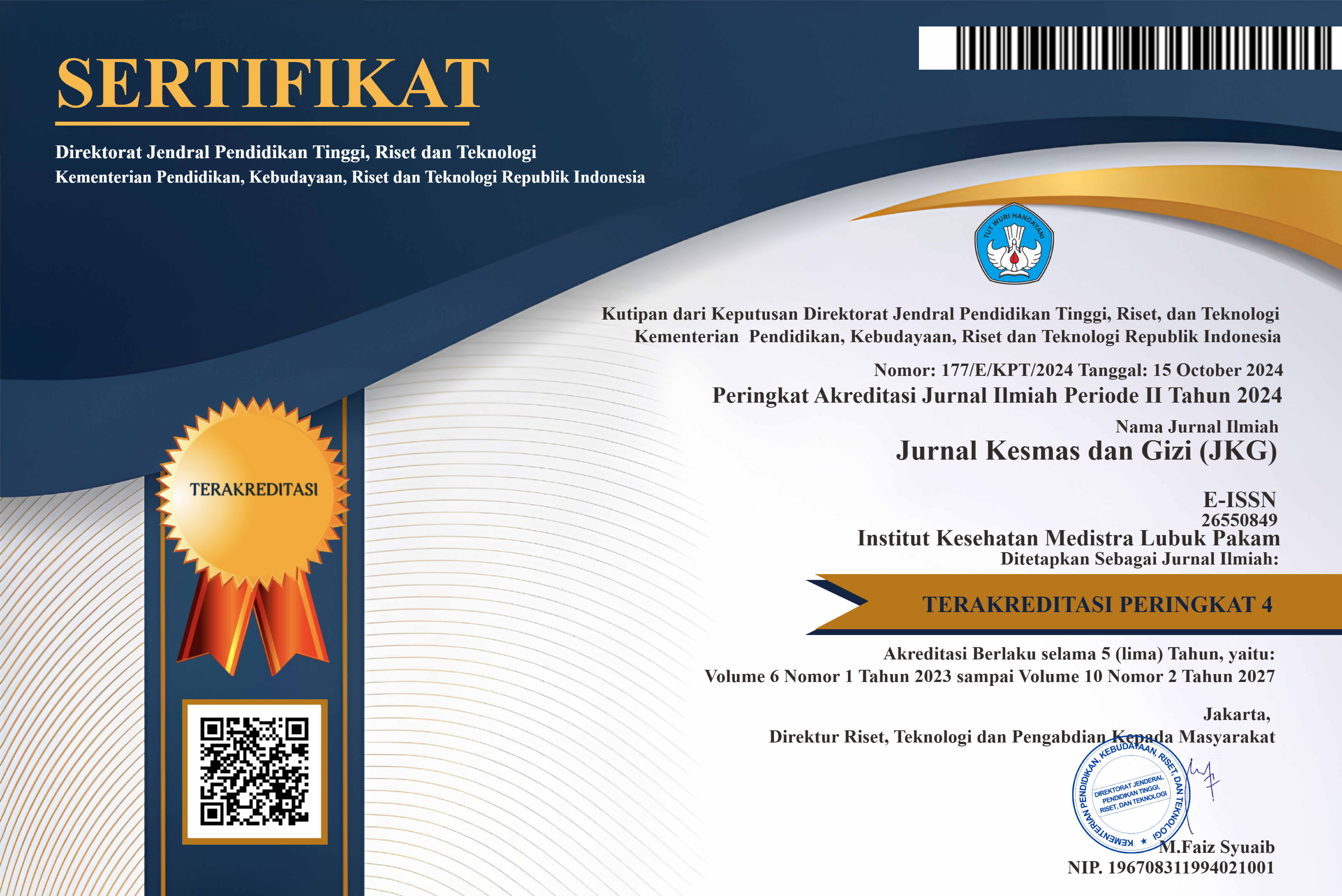DETERMINANT FACTORS RELATED TO THE INCIDENT OF STUNTING IN CHILDREN AGED 24-59 MONTHS IN ALAI SELATAN VILLAGE WORKING AREA OF ALAI PUSKESMAS UPT MERANTI ISLAND DISTRICT
DOI:
https://doi.org/10.35451/jkg.v6i1.1917Keywords:
Stunting; Low Birth Weight; Exclusive Breastfeeding; Environmental SanitationAbstract
Stunting is a condition of hindered child growth, which can be attributed to various factors, including a history of low birth weight (LBW), exclusive breastfeeding practices, and the cleanliness of the environment. The primary objective of this research is to pinpoint the factors associated with stunting among children aged 24-59 months in South Alai Village, which falls under the jurisdiction of UPT Puskesmas Alai in Kepulauan Meranti Regency. The data collection period for this study spanned from May 29 to June 20, 2023, and it involved the use of questionnaires and stadiometer measurements. The research design is analytical, utilizing a cross-sectional approach, with data analysis encompassing both univariate and bivariate analyses, including the Chi-Square test.The univariate analysis revealed the following statistics: out of the total sample, 53 toddlers (73%) did not exhibit signs of stunting, 69 toddlers (95%) were never born with LBW, 71 toddlers (97%) received exclusive breastfeeding, and 68 toddlers (93%) resided in environments characterized by satisfactory sanitation conditions. The results of the Chi-Square test, however, indicated that there is no significant relationship between a history of LBW, exclusive breastfeeding practices, environmental sanitation conditions, and the occurrence of stunting (p-value = 1.000).In summary, the majority of children aged 24-59 months in South Alai Village have not experienced LBW, received exclusive breastfeeding, and lived in environments with adequate sanitation. Consequently, there is no noteworthy association between a history of LBW, exclusive breastfeeding practices, environmental sanitation conditions, and the incidence of stunting in these children. The findings from this study are anticipated to enhance mothers' awareness regarding the significance of exclusive breastfeeding practices, appropriate nutrition for children beyond six months of age, and the importance of maintaining a clean environment to prevent the risk of stunting, particularly among toddlers. Mothers of toddlers are encouraged to improve their understanding of stunting, pay attention to their child's nutritional status, and regularly take their toddler to the local integrated health post (Posyandu) for growth and developmental monitoring.
Downloads
References
Anggraini, Y., & Nusantri Rusdi, P. H. (2020). Faktor yang berhubungan dengan stunting pada balita di wilayah kerja Puskesmas Air Bangis kabupaten Pasaman Barat. Jurnal Riset Kebidanan Indonesia, 3(2), 69–73. https://doi.org/10.32536/jrki.v3i2.56
Aramico, B., & Husna, Z. (2017). Analisis determinan stunting pada baduta di Wilayah Kerja Puskesmas tahun 2016. Jurnal Gizi dan Dietetik Indonesia (Indonesian Journal of Nutrition and Dietetics), 4(3), 154. https://doi.org/10.21927/ijnd.2016.4(3).154-160
Aryu, C. (2020). Epidemiologi Stunting . Universitas Diponegoro Fakultas Kedokteran.
Astutik, A., Rahfiluddin, M. Z., & Ronny, A. (2018). Faktor Risiko Kejadian Stunting pada Anak Balita Usia 24-59 Bulan (Studi Kasus di Wilayah Kerja Puskesmas Gabus II Kabupaten Pati Tahun 2017. Jurnal Kesehatan Masyarakat, 1(6), 409–418.
Herman, H., Maesarah, Safrudin T, & Hairil A. (2022). Analisis Determinan Kejadian Stunting pada Balita Usia 24-59 Bulan di Puskesmas Telaga Kabupaten Gorontalo Tahun 2022. Jurnal Graha Medika Public Health Journal, 1(2), 144–153.
Kemenkes RI. (2020). Peraturan Menteri Kesehatan Republik Indonesia Nomor 2 Tahun 2020?: Standar Antropometri Anak. Menteri Kesehatan Republik Indonesia.
Kemenkes RI. (2022). Buku Saku Hasil Survei Status Gizi Indonesia (SSGI) Tahun 2022. Badan Kebijakan Pembangunan Kesehatan Kementerian Kesehatan Republik Indonesia.
Kusharisupeni, P. (2002). Growth Faltering pada Bayi di Kabupaten Indramayu Jawa Barat. Jurnal Makara Kesehatan Universitas Indonesia, 6(1).
Kusnedi. (2018). Sanitasi Lingkungan dan Keberadaan Bakteri pada Air Minum dengan Risiko Diare di Sekolah Dasar yang Ada di Denpasar. Politekni Kesehatan Denpasar.
Proverawati, & Isnawati. (2010). BBLR (Berat Badan Lahir Rendah). Nuha Medika.
Rahayu, L. S., & Sofyaningsih, M. (2011). Pengaruh BBLR (berat badan lahir rendah) dan Pemberian ASI Eksklusif Terhadap Perubahan Status Stunting pada Balita di Kota dan Kabupaten Tangerang Provinsi Banten. Jurnal Prosiding Seminar Nasional “Peran Kesehatan Masyarakat dalam Pencapaian MDG’s di Indonesia”.
Supariasa. (2001). Penilaian Status Gizi. Penerbit Buku Kedokteran EGC.
Downloads
Published
Issue
Section
License
Copyright (c) 2023 Rahma Usfita Sari

This work is licensed under a Creative Commons Attribution 4.0 International License.
Copyright in each article is the property of the Author.



























